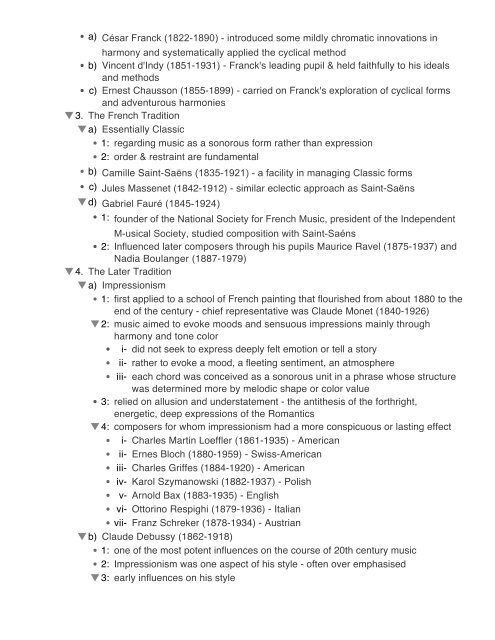An Outline of The History of Western Music Grout ... - The Reel Score
An Outline of The History of Western Music Grout ... - The Reel Score
An Outline of The History of Western Music Grout ... - The Reel Score
You also want an ePaper? Increase the reach of your titles
YUMPU automatically turns print PDFs into web optimized ePapers that Google loves.
a) César Franck (1822-1890) - introduced some mildly chromatic innovations in<br />
harmony and systematically applied the cyclical method<br />
b) Vincent d'Indy (1851-1931) - Franck's leading pupil & held faithfully to his ideals<br />
and methods<br />
c) Ernest Chausson (1855-1899) - carried on Franck's exploration <strong>of</strong> cyclical forms<br />
and adventurous harmonies<br />
3. <strong>The</strong> French Tradition<br />
a) Essentially Classic<br />
1: regarding music as a sonorous form rather than expression<br />
2: order & restraint are fundamental<br />
b) Camille Saint-Saëns (1835-1921) - a facility in managing Classic forms<br />
c) Jules Massenet (1842-1912) - similar eclectic approach as Saint-Saëns<br />
d) Gabriel Fauré (1845-1924)<br />
1: founder <strong>of</strong> the National Society for French <strong>Music</strong>, president <strong>of</strong> the Independent<br />
M-usical Society, studied composition with Saint-Saéns<br />
2: Influenced later composers through his pupils Maurice Ravel (1875-1937) and<br />
Nadia Boulanger (1887-1979)<br />
4. <strong>The</strong> Later Tradition<br />
a) Impressionism<br />
1: first applied to a school <strong>of</strong> French painting that flourished from about 1880 to the<br />
end <strong>of</strong> the century - chief representative was Claude Monet (1840-1926)<br />
2: music aimed to evoke moods and sensuous impressions mainly through<br />
harmony and tone color<br />
i- did not seek to express deeply felt emotion or tell a story<br />
ii- rather to evoke a mood, a fleeting sentiment, an atmosphere<br />
iii- each chord was conceived as a sonorous unit in a phrase whose structure<br />
was determined more by melodic shape or color value<br />
3: relied on allusion and understatement - the antithesis <strong>of</strong> the forthright,<br />
energetic, deep expressions <strong>of</strong> the Romantics<br />
4: composers for whom impressionism had a more conspicuous or lasting effect<br />
i- Charles Martin Loeffler (1861-1935) - American<br />
ii- Ernes Bloch (1880-1959) - Swiss-American<br />
iii- Charles Griffes (1884-1920) - American<br />
iv- Karol Szymanowski (1882-1937) - Polish<br />
v- Arnold Bax (1883-1935) - English<br />
vi- Ottorino Respighi (1879-1936) - Italian<br />
vii- Franz Schreker (1878-1934) - Austrian<br />
b) Claude Debussy (1862-1918)<br />
1: one <strong>of</strong> the most potent influences on the course <strong>of</strong> 20th century music<br />
2: Impressionism was one aspect <strong>of</strong> his style - <strong>of</strong>ten over emphasised<br />
3: early influences on his style<br />
i- immediate background included Franck, Saint-Saëns, Emmanuel Chabrier<br />
(1841-1894) as well comtemporary French painters and poets who<br />
impacted his thinking





